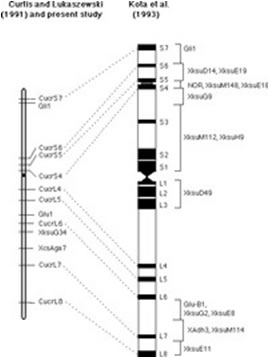

Genetic distance vs. physical distance
The one to one relationship between cM and nucleotides generally holds, but there are exceptions. The recombination rate is not constant along the length of the chromosome - almost always, recombination is suppressed near the centromere and amplified close to the telomere. Thus a small genetic distance in the centre of the chromosome may reflect a very large physical separation; while a large genetic distance at the chromosome tip may be associated with a very small physical segment. This explains the clustering of markers which is very typical of many genetic maps.
 |
Genetic and physical maps of chromosome 1B of wheat. Short arms are at the top. The map by Kota et al. (1993) was constructed on a physical chromosome length (%) basis and the Curtis and Lukaszewski (1991) map is based on linkage of C-bands, protein and DNA markers. Markers preceded by an X are DNA markers and C are C-bands. Dotted lines show orthologous loci. The darkened region on the linkage map and the constriction on the physical map represent the centromeres.
From van Deynze et al. (1995); also available at GrainGenes: http://wheat.pw.usda.gov/cgi-bin/graingenes/report.cgi?class=image;name=1B+physical+vs.+genetic+maps |

